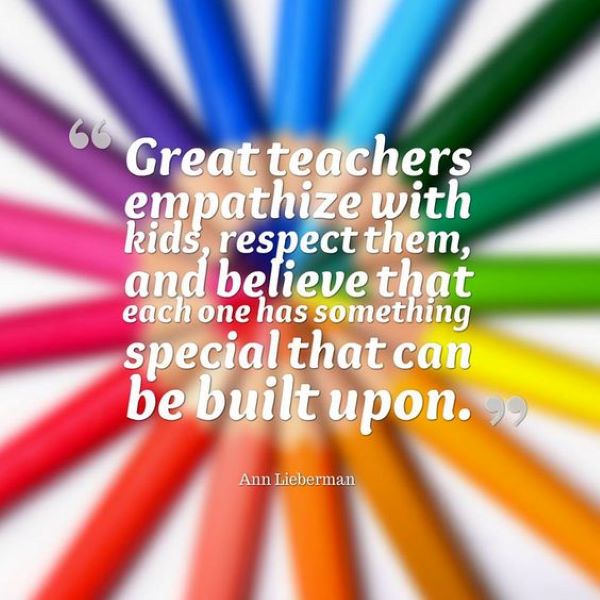Often Overlooked Traits That a Good Language Teacher Make
By David Shaffer
Every teacher wants to be outstanding in their profession, but does everyone want to put in the required effort? In our earlier installments on the topic of good teacher traits, we concentrated on the more obvious ones. Here, we look at some that are less discernible but still very potent in the effect that they can produce. As you read through the article, please take the time to engage with the Moment for Reflection sections.
Having Patience
Being patient has never been my strong suit. I guess I take after my father in that respect. But patience can be learned, and as a teacher, I learned patience once I realized how valuable it is in teaching a language. A case in point: When we ask a question in class, especially a yes/no question, we inherently expect a rather quick reply – all they have to do is say “yes” or “no,” we think. But the student has to do a lot more. They have to decode the teachers question; they have to think of an answer; they need to construct an answer in English, keeping grammaticality in mind; and they need to think of how to best pronounce what they want to say. This takes time, and if the teacher is patient and gives them this time, learning will take place. This is a prime example of where “Silence is golden” holds true.
By being patient, the teacher creates a safe and encouraging classroom environment for the students. We’re all familiar with the student who makes the same grammatical error over and over again, even though we have corrected their error time and time again. But we need to show tolerance. Learning a language item is not instantaneous: It takes time for the student to “unlearn” the incorrect rule that they have formed before they are able to replace it with the correct form. Again, patience is called for on the part of the teacher.
Every student is different. Even though all the students in the class may be the same age, the same gender, the same height, and have the same hair color, their second language proficiency is sure to be different. As teachers, it is easy for us to fall into the trap of recognizing the higher proficiency students in the class as “standard” and expect the other students to meet that standard. (Why? Because they have the same hair color?!). Rather than have unrealistic expectations, we need to be patient and allow the lower proficiency students to advance at their own pace, just as the higher-proficiency students will advance at their own pace. Teacher patience creates a favorable classroom environment, which in turn, creates motivated students.
→ Moment for Reflection: How much patience do you exhibit in waiting for students to answer questions, to fix repeated errors, and to improve at a realistic pace?

Having Empathy
Let’s begin by saying what empathy is not: Empathy is not the same as sympathy. Sympathy is saying “I’m sorry to hear that” or “That’s too bad.” It is a feeling of sorrow or pity for another’s misfortune – but from their own perspective. Empathy, on the other hand, is the ability to understand another’s thoughts and feelings from the other’s perspective. Teachers need to understand their students, and they need to show that they truly understand their students. This can be challenging when the class meets only three hours a week or less. And it can be especially challenging when the teacher’s first language and home culture are quite different from those of their students. But the effort needs to be made because students will notice if you are understanding of their situation or point of view and if you are being truly empathetic. If you are, the students will pick up on this, and the classroom learning environment will be that much more positive, warm, friendly, and motivating for the students.
→ Moment for Reflection: How much of the time do you spend trying to understand your student’s problems from their perspective and being empathetic as opposed to relying on your own perspective as a teacher?
Being Flexible / Adaptable / Problem-Solving
Viewing situations from the students’ perspective is one of the things that requires a degree of teacher flexibility, but there are quite a few others. Very rarely does a lesson proceed exactly as the teacher has envisioned. The activity you prepared may take much longer to complete than expected. Student questions may take much longer than the allocated time. What to do? Rush through the rest of the lesson plan to get everything “in” in the little time remaining because that’s what the original plan was? Or do you exhibit flexibility by continuing at the students’ speed rather than that spelled out in your lesson plan? The knowing teacher will choose the latter, being aware that little is learned when material is hurriedly presented.
An excellent example of adaptability is that sparked by the pandemic when suddenly all in-person teaching was mandated to go online. It was the flexible teacher who adapted to the new, unfamiliar teaching environment most quickly and most adequately. The transition was not trouble-free for anyone, though. However, it was the flexible, adaptable teachers who most effortlessly and most readily solved their classroom-to-online teaching conundrums.
→ Moment for Reflection: On a scale of 1 to 10, how flexible/adaptable are you as a teacher? Can you think of a prime example from your pandemic teaching experiences?
Being Open-minded
This is related to the above but will get separate mention here. Open-mindedness is the readiness to consider something without a preconceived opinion. What is so easy for a teacher to do is to fall into the trap of using the least demanding procedures in teaching or teaching the way they were taught rather than adopting new and improved teaching methods that are so often being developed. Having teaching routines is commendable; closed-mindedness, however, allows those routines to morph into ruts.
Being open-minded with your students is especially important; it is advantageous in creating a safer, more nonthreatening classroom environment. When a student comes to class late, do you immediately think that it is due to them partying the night before? When a student turns in their homework late, do you immediately dock them points without asking for the reason? They may have very good reasons for their lateness. Get to know your students. Ask them for their opinions on what types of topics interest them, what types of activities energize them, and what types of media motivate them. Teacher open-mindedness leads to more student learning.
→ Moment for Reflection: On a 1–10 scale, how open-minded do you consider your teacher self to be? Can you think of five good examples?
Having Curiosity
Again piggybacking on a previously mentioned teacher trait (i.e., open-mindedness) is curiosity. The teacher with curiosity asks their students questions to find out more about them, about their most-enjoyed activities, about their most-liked learning styles. Teacher inquiry into their students shows that the teacher is truly interested in the students and, in turn, creates student motivation.
Curiosity is asking why. Why do so many students make the same grammar error? Why do they use that word with a wrong meaning? Why don’t they have any questions for Q&A time? The curious teacher will search for and discover the answers to these questions, and then adjust accordingly. Contrary to popular opinion, curiosity did not kill the cat, instead it can liven up your classroom as well as level up your teaching methods.
→ Moment for Reflection: Are you as curious as a cat? How many language teaching-related items have you been curious about in the past week? How many have you followed up on, searching for an answer? How many have you found the solution to and put in into action?

Being Creative, Resourceful
If curiosity is asking why, then creativity and resourcefulness are about asking yourself what and how. It is very rare that a teacher will have all the materials that they would like to have for their classes. They can just accept the status quo and do without, or they can search for a substitute solution, as a creative teacher would do. If the board on the wall is too small to accommodate enough students, the creative teacher will ask themself “What can I do,” come up with a solution, and then ask “How can I do it?” The result may be an individual whiteboard for each student made by just laminating an A4 sheet of paper! Creativity! Another teacher would like puppets for each student. The teacher has the students each draw a face on a sheet of paper, cut it out, and glue it to a wooden chopstick. Voila! A puppet! The activity in the coursebook is too teacher-centered and on a topic of little interest to the students. The creative teacher will change it up to make it more student-centered and on a more interesting topic. More teacher magic!
→ Moment for Reflection: What have you done in the past month to demonstrate your creativity and resourcefulness?
Having a Sense of Humor
The classroom without humor can be b-o-r-i-n-g. Humor can help keep the students alert and motivated, and help to create a safe and nonthreatening classroom environment. However, there is a fine line between being a humorous teacher and a clown. A humorous teacher acts professionally; a clown in the classroom does not. I will never forget passing by a university teacher’s classroom and seeing him prancing up and down the aisles. I’ve always wondered how this could be related to his lesson, or what educational value it might have had. It seemed like the teacher was more interested in keeping the class happy than in teaching them English. Humor should have some pedagogical purpose. Adding a sprinkling of humor is a good way to garnish any lesson plan.
→ Moment for Reflection: Do you interject a proper amount of humor into your classroom teaching? Is it helpful in creating a favorable learning environment?
Being Professional
Being professional encompasses a wide variety of items – from the way one dresses to keeping up with the latest developments in one’s field. Being professional is more than just what the teacher considers it to be; one must take into account the students’ concept of what a professional teacher is like. Wearing shorts and sandals may be acceptable for a teacher in Florida, but students in Korea would not expect that from a teacher. Working with students in a culture that is different from yours requires close observance of what teachers of that culture do and consider to be professional conduct.
→ Moment for Reflection: Are you doing all that you can do to demonstrate professionalism in your work? Name five areas in which you consider yourself to best exhibit professionalism as a teacher.
Caring for One’s Own Health
The classroom teacher is concerned about their students; they are concerned about preparing their daily lesson plans; and they are busy correcting homework and grading tests, often until late at night. They are so busy thinking about their classes and their students that they forget about themselves. It is the healthy teacher who is the better teacher. They will see that they get enough exercise, get enough sleep, eat nutritious foods, and get enough rest and relaxation.
→ Moment for Reflection: Do you take enough care about you physical and mental health? Name five ways that demonstrate that you do. In what areas could you do better?
In our previous articles on great teacher traits, we discussed 15 items. They are listed here for your convenience and for your reflection:
- Understanding of the subject matter
- Using current teaching methodology and techniques
- Using a well-balanced teaching approach
- Being a lifelong learner
- Belonging to a professional learning community
- Having a passion for teaching
- Knowing one’s students
- Understanding students’ needs
- Knowing how to engage one’s students
- Creating an environment for learning
- Incorporating technology
- Excelling at classroom management
- Having cultural competence
- Having good communication skills
- Having good organizational skills
Gwangju-Jeonnam KOTESOL
Upcoming Event
Gwangju-Jeonnam Regional Conference
- Date: October 28, 2023 (Saturday)
- Conference Theme: Undead ELT?: Humanizing Language Teaching in Postnormal Times
- Venue: Gwangju National University of Education
- Website: https://koreatesol.org/content/gwangju-jeonnam-kotesol-regional-conference-2023-0
Check the Chapter’s webpages and Facebook group periodically for updates on chapter events and other in-person and online KOTESOL activities.
For full event details:
- Website: http://koreatesol.org/gwangju
- Facebook: Gwangju-Jeonnam KOTESOL
The Author
David Shaffer, PhD, has been involved in TEFL, teacher training, writing, and research in Gwangju for many years as a professor at Chosun University. As vice-president of the Gwangju-Jeonnam Chapter of KOTESOL, he invites you to participate in the chapter’s upcoming conference, as well as its monthly teacher development workshops and other events (in person and online), and in KOTESOL activities in general. Dr. Shaffer is a past president of KOTESOL and is the editor-in-chief of the Gwangju News.




